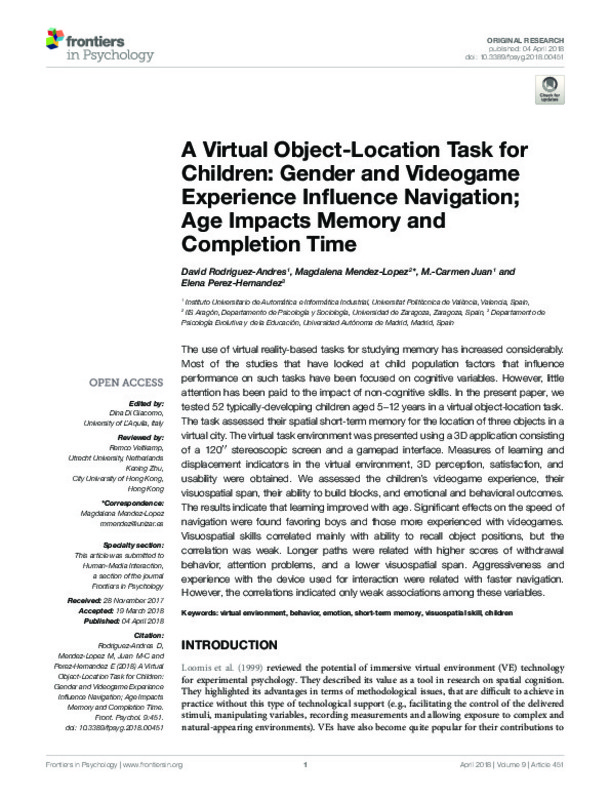JavaScript is disabled for your browser. Some features of this site may not work without it.
Buscar en RiuNet
Listar
Mi cuenta
Estadísticas
Ayuda RiuNet
Admin. UPV
A Virtual Object-Location Task for Children: Gender and Videogame Experience Influence Navigation; Age Impacts Memory and Completion Time
Mostrar el registro sencillo del ítem
Ficheros en el ítem
| dc.contributor.author | Rodríguez-Andrés, D.
|
es_ES |
| dc.contributor.author | Mendez-Lopez, M.
|
es_ES |
| dc.contributor.author | Juan, M.-Carmen
|
es_ES |
| dc.contributor.author | Perez-Hernandez, E.
|
es_ES |
| dc.date.accessioned | 2020-07-02T06:50:21Z | |
| dc.date.available | 2020-07-02T06:50:21Z | |
| dc.date.issued | 2018-04-04 | es_ES |
| dc.identifier.uri | http://hdl.handle.net/10251/147307 | |
| dc.description.abstract | [EN] The use of virtual reality-based tasks for studying memory has increased considerably. Most of the studies that have looked at child population factors that influence performance on such tasks have been focused on cognitive variables. However, Little attention has been paid to the impact of non-cognitive skills. In the present paper, we tested 52 typically-developing children aged 5¿12 years in a virtual object-location task. The task assessed their spatial short-term memory for the location of three objects in a virtual city. The virtual task environment was presented using a 3D application consisting of a 12000 stereoscopic screen and a gamepad interface. Measures of learning and displacement indicators in the virtual environment, 3D perception, satisfaction, and usability were obtained. We assessed the children¿s videogame experience, their visuospatial span, their ability to build blocks, and emotional and behavioral outcomes. The results indicate that learning improved with age. Significant effects on the speed of navigation were found favoring boys and those more experienced with videogames. Visuospatial skills correlated mainly with ability to recall object positions, but the correlation was weak. Longer paths were related with higher scores of withdrawal behavior, attention problems, and a lower visuospatial span. Aggressiveness and experience with the device used for interaction were related with faster navigation. However, the correlations indicated only weak associations among these variables. | es_ES |
| dc.description.sponsorship | This work was funded mainly by the Spanish Ministry of Economy, Industry and Competitiveness (MINECO) through the CHILDMNEMOS project (TIN2012-37381-C02-01) and co-financed by the European Regional Development Fund (FEDER). Other financial support was received from the Generalitat Valenciana (Conselleria d Educació, Investigació, Cultura i Esport) through the grant for consolidable research groups (AICO/2017/041), the Gobierno de Aragón (Departamento de Innovación, Investigación y Universidad), and the FEDER Construyendo Europa desde Aragón . | es_ES |
| dc.language | Inglés | es_ES |
| dc.publisher | Frontiers Media SA | es_ES |
| dc.relation.ispartof | Frontiers in Psychology | es_ES |
| dc.rights | Reconocimiento (by) | es_ES |
| dc.subject | Virtual environment | es_ES |
| dc.subject | Behavior | es_ES |
| dc.subject | Emotion | es_ES |
| dc.subject | Short-term memory | es_ES |
| dc.subject | Visuospatial skill | es_ES |
| dc.subject | Children | es_ES |
| dc.subject.classification | LENGUAJES Y SISTEMAS INFORMATICOS | es_ES |
| dc.title | A Virtual Object-Location Task for Children: Gender and Videogame Experience Influence Navigation; Age Impacts Memory and Completion Time | es_ES |
| dc.type | Artículo | es_ES |
| dc.identifier.doi | 10.3389/fpsyg.2018.00451 | es_ES |
| dc.relation.projectID | info:eu-repo/grantAgreement/MINECO//TIN2012-37381-C02-01/ES/DESARROLLO Y VALIDACION DE SISTEMAS DE REALIDAD VIRTUAL Y AUMENTADA PARA EVALUAR LA MEMORIA ESPACIAL A CORTO PLAZO EN NIÑOS/ | es_ES |
| dc.relation.projectID | info:eu-repo/grantAgreement/GVA//AICO%2F2017%2F041/ | es_ES |
| dc.rights.accessRights | Abierto | es_ES |
| dc.contributor.affiliation | Universitat Politècnica de València. Departamento de Sistemas Informáticos y Computación - Departament de Sistemes Informàtics i Computació | es_ES |
| dc.description.bibliographicCitation | Rodríguez-Andrés, D.; Mendez-Lopez, M.; Juan, M.; Perez-Hernandez, E. (2018). A Virtual Object-Location Task for Children: Gender and Videogame Experience Influence Navigation; Age Impacts Memory and Completion Time. Frontiers in Psychology. 9:1-13. https://doi.org/10.3389/fpsyg.2018.00451 | es_ES |
| dc.description.accrualMethod | S | es_ES |
| dc.relation.publisherversion | https://doi.org/10.3389/fpsyg.2018.00451 | es_ES |
| dc.description.upvformatpinicio | 1 | es_ES |
| dc.description.upvformatpfin | 13 | es_ES |
| dc.type.version | info:eu-repo/semantics/publishedVersion | es_ES |
| dc.description.volume | 9 | es_ES |
| dc.identifier.eissn | 1664-1078 | es_ES |
| dc.identifier.pmid | 29674988 | es_ES |
| dc.identifier.pmcid | PMC5895853 | es_ES |
| dc.relation.pasarela | S\356539 | es_ES |
| dc.contributor.funder | Gobierno de Aragón | es_ES |
| dc.contributor.funder | Generalitat Valenciana | es_ES |
| dc.contributor.funder | European Regional Development Fund | es_ES |
| dc.contributor.funder | Ministerio de Economía y Competitividad | es_ES |








